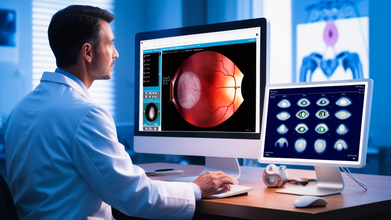- Health Conditions A-Z
- Health & Wellness
- Nutrition
- Fitness
- Health News
- Ayurveda
- Videos
- Medicine A-Z
- Parenting
- Web Stories
What Are The Best Sugar Substitutes For People with Diabetes?

Artifical sweetners (Credit: Canva)
Artificial sweeteners, often labeled as "diabetes-friendly," may not be the ideal choice for managing blood sugar levels. Despite their low- to no-calorie count, recent studies suggest these substitutes might have unintended consequences, including a potential link to higher obesity and diabetes rates. However, healthier alternatives exist, and understanding the options can help make informed dietary decisions.
Should You Use Artificial Sweeteners?
Certain sugar substitutes can aid in blood sugar management, including:
- Stevia
- Tagatose
- Monk fruit extract
- Coconut palm sugar
- Date sugar
- Sugar alcohols like erythritol or xylitol
Stevia: A Natural Choice
Stevia, a plant-based sweetener, offers several benefits for people with diabetes. Approved by the Food and Drug Administration (FDA), it is known for its antioxidant and antidiabetic properties. Unlike artificial sweeteners, stevia can:- Stabilize blood sugar levels
- Increase insulin production and effectiveness
- Counteract type 2 diabetes mechanisms
However, processed stevia products, such as Truvia or SweetLeaf, may contain additional ingredients, including sugar alcohols, which could impact glucose levels. Further research is needed to understand the long-term effects of these products.
Exploring Tagatose
Tagatose is a naturally occurring sugar that shows promise as a diabetes-friendly alternative. Research highlights its potential to:
- Lower blood sugar and insulin responses
- Reduce carbohydrate absorption
- Support antidiabetic and antiobesity effects
While tagatose appears safe, more studies are necessary to confirm its efficacy. Consulting a healthcare provider before incorporating it into your diet is advisable.
Additional Sweet Options
For a natural touch, consider these alternatives:
- Monk fruit extract, a low-calorie option gaining popularity.
- Date sugar, made from whole dates, retains fiber but does not reduce calorie content.
- D-allulos*, a sugar substitute found in foods like figs and wheat, offers a lower glycemic impact.
Whole fruits remain the best natural sweetener, as they provide fiber and essential nutrients without added risks.
The Risks of Artificial Sweeteners
Although marketed as "sugar-free" or "diabetic-friendly," artificial sweeteners can disrupt natural taste mechanisms, potentially increasing cravings and overeating. Studies have linked higher artificial sweetener consumption to an elevated risk of diabetes and glucose intolerance.
Artificial sweeteners may also:
- Alter gut bacteria, affecting weight management
- Contribute to weight gain, a significant diabetes risk factor
The World Health Organization (WHO) advises against using non-nutritive sweeteners for weight management, including artificial options like stevia blends.
Sugar Alcohols
Sugar alcohols, often labeled in "sugar-free" products, can partially raise blood sugar levels. These compounds, such as erythritol and xylitol, are metabolized differently than sugar and may be easier to tolerate in small amounts. However, excessive consumption can cause digestive discomfort and, in rare cases, heart health concerns.
Thus, for individuals with diabetes, artificial sweeteners may not be the best sugar substitute due to potential long-term risks. Natural options like pure stevia, monk fruit, or date sugar are healthier choices but should still be used in moderation. Ultimately, reducing added sweeteners in any form helps manage sugar cravings and improve overall health. Always consult a healthcare provider to determine the most suitable options for your dietary needs.
'Felt Like Losing Control Of My Mind, And Sense Of Self', Reveals RTE Star Lottie Ryan About Her Perimenopause Experience

Credits: Canva
Lottie Ryan, Irish television and radio presenter with RTE opened up about her perimenopause experience and how she felt 'out of control' before she realized that changes in her body was going through were hormonal.
She revealed that she felt she was 'losing control', as reported by the Irish Sun. She said that she initially could not understand why she was feeling so off and blamed the symptoms on stress. However, only after she had a chat with her mother that she realized her issues could be hormonal.
After having a conversation with her mother, she booked a follow-up with a medical professional, who confirmed that her symptoms were due to perimenopause.
She spoke to Natural Life Magazine, and said, "At first I did not put two and two together, I just thought I was stressed, tired, maybe run down. It was not until I had a conversation with my mum about what she would gone through, then spoke to my childhood best friend, who is a women's health physio, that I started to thin, 'Hand on...this could be hormonal'."
She had recently turned 40, and recalled how her symptoms began to affect every part of her life. She said, "Before I knew what was going on, I felt like I was losing control of my mind, my memory, even my sense of self."
She further added, "One I got answers, it was like a fog lifted. I still have days where I have to manage things, but now I understand why they're happening, and that makes all the difference." She tells that what surprised her was the anxiety she started to feel. She revealed that she thought menopause was "about hot flushes and trouble sleeping". What she did not know was that it could affect your mental health. She says, "That was the biggest shock for me."
Read More: F.D.A. Approves New Non-hormonal Menopause Drug To Reduce Hot Flashes
What Is Perimenopause?
As per a 2019 study published in Journal of Clinical Obstetrics and Gynecology, perimenopause, or the menopausal transition, represents a period of time during which newly arising symptoms can present complex management decisions for providers. It is the period of time during which physiologic changes mark progression toward a woman's final menstrual period (FMP).
The phase begins with the onset of menstrual irregularities and continues until a woman reaches menopause, or one year after amenorrhea has occurred.
As Jean Miller, NP, at Franciscan Physician Network Winfield Health Center explains, "Perimenopause is the transition that occurs between a woman’s reproductive years and menopause, usually starting seven to ten years before the final period. It is important to remember that while this is a natural process, it is also one that varies for each woman, with some noticing little change and other experiencing more significant symptom."
Since the average age of menopause is 51, most women start to notice perimenopause symptoms in their 40s, which is also the case with Ryan.
Gynecologist psychiatrist Dr Nazanin Silver, writes for the American College of Obstetricians and Gynecologists that about 4 in 10 women have mood symptoms during perimenopause, which may be similar to PMS. She notes that women may feel irritable, have low energy, feel tearful and moody, or have a hard time concentrating.
She also notes that there are multiple studies that point out the increasing risk of depression during menopausal transition. Women may feel like they are crying a lot, feel hopeless or worthless, numb or lose interest from their liked and normal activities. Anxiety too is one of the symptoms.
She suggests during this phase, it is important to "see your ob-gyn regularly and discuss how you are feeling". Finding help can help you enter this phase with ease.
Heart Diseases Risk and Aging Health Issues Could Be Predicted By A Simple Eye Scan: Study Showed 70% Accuracy

(Credit-Canva)
Heart diseases are one of the most common issues people face in the world. Despite being the leading cause of death globally, according to the world health organization, many people miss critical signs of it. The best way to ensure a person gets treatment, is that the disease must be diagnosed in its early stages. A new study suggests diagnosing the risk of heart disease early is also possible, with the help of eye scans.
Researchers at McMaster University and the Population Health Research Institute (PHRI) have made an incredible discovery. They found that the tiny blood vessels in your eyes could be a powerful way to guess how likely you are to develop heart disease and how fast your body is truly aging on the inside. This is a big deal because right now, checking for these risks involves many complicated tests.
The study, which was published in the journal Science Advances, suggests that soon, doctors might be able to use a simple scan of your retina, which is the back of your eye, as a quick and non-invasive tool. This scan could show them the overall health of your blood circulation and reveal your body’s real biological age. This new method could open up amazing possibilities for catching serious health issues much earlier.
Can You Diagnose Heart Diseases From Eye Scan?
The study was massive, involving over 74,000 people from large international research groups. The scientists analyzed their retinal images, genetic makeup, and blood data.
Their key discovery was striking, people whose blood vessels in the retina were simpler and looked less branched (not as tree-like) were found to be at a higher risk for heart problems. These same people also showed clear signs of faster biological aging, meaning they had more inflammation in their bodies and a potentially shorter life expectancy.
Dr. Marie Pigeyre, one of the main researchers on the study, explains that the eye is unique. It gives doctors a special, clear, and easy way to look at your entire circulatory system—all the veins and arteries that carry blood throughout your body.
Mirroring the Body
Think of the eye's small blood vessels like a mirror. Changes happening in these vessels reflect the same changes happening in the small blood vessels everywhere else in your body. If the vessels in your eye look unhealthy, chances are, the vessels around your heart and brain are also struggling.
Molecular Clues
The team didn't just look at pictures. By combining the retinal scans with genetic information and blood test results, they were able to uncover specific "molecular pathways." These are basically the biological rules or processes that explain exactly how aging causes problems in your blood vessel system.
Can You Cure Genetic Heart Diseases?
The researchers went beyond just finding a link; they used the blood and genetic data to hunt for the root causes of these eye vessel changes. This led them to pinpoint specific proteins that appear to be the main drivers of both aging and disease.
They identified two major proteins: MMP12 and IgG–Fc receptor IIb. Both of these are strongly linked to inflammation and the deterioration of blood vessels as we age.
Dr. Pigeyre is excited because these specific proteins could become targets for new drugs. Medicines designed to control or slow down these proteins could help reduce the impact of vascular aging, lower the risk of heart disease, and ultimately help people live longer and healthier lives.
Right now, to check for serious age-related diseases like heart disease, stroke, and memory problems (dementia), doctors have to perform many different tests. The big hope is that a quick, simple retinal scan could one day become an easy-to-access tool to immediately check a person's risk for heart problems and determine their biological age.
Ask These 3 Questions To Your GP To Avoid Being Misdiagnosed, According To Doctor

(Credit-Canva)
It is not uncommon for women’s health concerns to be overlooked even by professionals. Often chalking up their health issues as, ‘common women ailments’, many healthcare professionals, miss the core reason for women’s symptoms. In a recent video, Dr Karan Rajan, an NHS Surgeon, shared a video, explaining how often, even signs of chronic illnesses can get overlooked as just ‘anxiety’.
So, is there no way a person can ensure they have the right diagnosis? In the video Dr Karan listed a few ways one can ensure they have the right diagnosis, from asking the right questions and how to proficiently communicate your symptoms to the doctor.
What Questions Should You Ask Your Doctor?
If your doctor told you that your health problems are "just anxiety," remember that you have the right to push for a more thorough checkup. One should ask the right questions as it is their health on the line. Being ready shows you're serious and ensures your doctor looks into your condition properly.
Dr. Karan explains that when talking to your doctor, you should ask questions that make them explain why they settled on an anxiety diagnosis. This shifts the focus back to the doctor, requiring them to justify their medical opinion. Here are the key questions you should use.
"What tests have been done to rule out other causes of my symptoms?"
This question is powerful because it makes the doctor list exactly what they have investigated. It clarifies the boundaries of the investigation. If the doctor hasn't run many tests, you know there's more ground to cover.
"Can you explain why you think this is anxiety and not a physical medical condition?"
Don't accept "your blood work is fine" as the only answer. That's often not enough. Many serious health conditions don't show up on a routine blood test. You want a detailed explanation of their thinking, not just a quick dismissal.
"Have we ruled out other conditions that can look exactly like anxiety?"
It's surprising how many physical illnesses have symptoms that are identical to anxiety. Dr Karan explains how thyroid problems like hypothyroidism, issues with your nervous system like dysautonomia, or even an immune disorder like mast cell activation syndrome, can all cause symptoms like a racing heart, dizziness, or panic. You want to be sure these possibilities have been considered.
Is It Anxiety Or A Health Condition?
If your doctor only suggests things like talk therapy and certain medications (like SSRIs), be prepared to ask for more. You need to know if they're looking at the big picture.
Dr Karan suggests that you should ask them: "What treatment plan would you suggest that goes beyond just treating the anxiety itself?"
If their only answer is medication and counseling, it's fair to ask what other medical routes or specialists can be explored to find the root cause of your symptoms.
How Should You Describe Your Symptoms?
When describing your symptoms, you need to be precise and give the doctor hard data. This makes it much harder for them to brush off your concerns as simple stress. Dr Karan gives an example, instead of just saying, "I get dizzy a lot," get into the details:
"I get dizzy when I stand up, especially in the morning. It's worse after eating or after I’ve been sitting for a long period of time."
This kind of specific detail is very important. Symptoms that happen when you stand up and improve when you lie down could point to a physical problem like Postural Orthostatic Tachycardia Syndrome (POTS), not just everyday anxiety.
The clearer and more factual you are, the less likely they are to dismiss your condition as just "generalized stress." Dr. Rajan emphasizes that "data talks." Start keeping a symptom diary right away! It's an essential tool for tracking your condition every day. In your log, record:
The exact time symptoms happened.
What you ate or drank beforehand.
What made the symptoms better or worse.
Look for patterns. Does the dizziness only happen after you stand up? Do your symptoms worsen after a certain meal, or around your sleep schedule, or with hormonal changes? Bringing this detailed log, to your appointment makes it much, much more difficult for any doctor to doubt or dismiss your concerns.
© 2024 Bennett, Coleman & Company Limited

